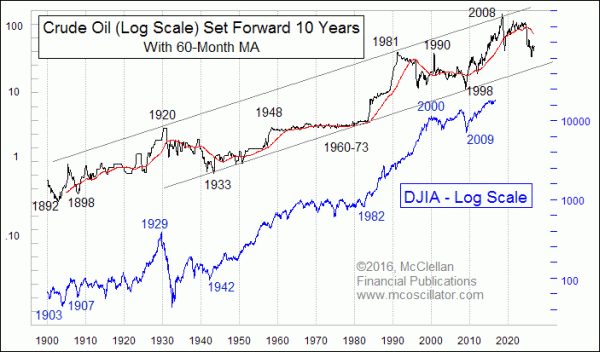Chart In Focus
DJIA, And the Echo of 2007-08 Oil Blowoff McClellan Financial Publications, Inc
Posted Oct 15, 2016 
October 13, 2016 If you want to know what the DJIA is going to do next year, just look back at what crude oil was doing 10 years ago. That is the message of this week’s chart, and it is one I have featured before. I love to find instances where one can get the answers ahead of time, and this is one of the best such relationships I have ever encountered. This discovery came about when I got ahold of some long-term data on crude oil prices, which had been gathered years ago by the Foundation for the Study of Cycles, and dating back as far as 1890. Once I got it on a chart, I realized that I had seen the pattern before, and that it was the pattern of the stock market in the 20th century. Putting the DJIA on the chart with crude oil prices proved that there was indeed a relationship, but the correlation was not quite right. Playing around with it a little bit showed that a 10-year forward offset for the crude oil price plot made for the best fit of the two patterns. Here is that long-term chart: Crude oil leads stock market by 10 years 
One important point to note is that the correlation has never been perfect. When there have been exogenous events like the Arab Oil Embargo, or the 1990 Iraq invasion of Kuwait, the DJIA has not followed the pattern exactly. Once those exogenous events reach their conclusion, the correlation gets back on track. The hard question that I have been grappling with for a few years now is whether the 2008 commodities bubble was one of those exogenous events. It produced a $145/barrel spot price for crude oil, mostly because hedge fund managers got all caught up in the idea that commodities were the new hot place to invest. Was that a real free market event which should have its true echo in the stock market 10 years after, or was it one of those events we should just put a thumb over on the chart, and forget that it even happened, focusing instead on the “getting back on track” part of the story? I promise to have a full and complete answer to that question in about 3 years. For now, though, we have to navigate what oil says is ahead, with the understanding that it might be erroneous information on account of the commodities bubble of 2008. Moving into 2017, we should see at least an echo of the initial part of oil’s uptrend. Whether that turns into the full-on bubble top oil made in 2008 is more in doubt, but we don’t have to worry about that yet. And the bottom that leads to that upturn into 2017 ought to be seen right here in the 4th quarter. At least the first few months of 2017 ought to reasonably make a proper echo of oil’s price movements in 2006-07. I’ll start to worry about what lies beyond when we get to the middle of 2017. *** Related Charts Mar 25, 2011

Oil Predicts Stock Market Dip | Aug 07, 2015

Peso’s Message For Crude Oil
| Jul 30, 2015

Debunking the Fed as the Controller of Inflation | ### Oct 13, 2016
Tom McClellan
Editor, The McClellan Market Report
email: tom@mcoscillator.com
website: www.mcoscillator.com
(253) 581-4889 Subscribe to Tom McClellan's free weekly Chart In Focus email. Copyright ©1996-2016, McClellan Financial Publications. All Rights Reserved. 321gold Ltd

| 




